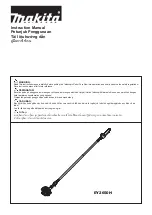
11
OVERVIEW
The upper position of the blade projects up through the table, surrounded by an insert called the
thru plate. The height of the blade is set with a hand wheel on the front of the cabinet. To
accommodate wide panels, the tabletop has extensions on each side. Detailed instructions are
provided in the Operation section of this manual for the basic cuts
:
Cross cuts, miter cuts, bevel
cuts, and compound cuts.
For cuts with the blade straight up and cutting across the grain (cross cuts or miter cuts), use the
miter gage to set the angle and push the wood into the blade. To cut with the blade straight up,
along the grain of the wood (rip cuts), use the rip fence to guide the wood Push smaller pieces with
a push block or push stick. To tilt the blade for a bevel cut, use the hand wheel on the side of the
cabinet. A bevel scale on the front of the cabinet shows the blades angle. Use the miter gauge with
a bevel cross cut (compound cut) and the rip fence with a bevel rip cut. Other cuts require special
attachments, which have detailed instruction to reduce risk of injury and ensure the best
performance from your new saw.
Before attempting to use your saw, familiarize yourself with all operating features and safety
requirements of your table saw. The saw
'
s features are described below .
ANTI-KICKBACK PAWLS –
Kickback is a hazard in which the work piece is thrown back toward
the operator. The toothed pawls are designed to snag the work piece to prevent or reduce injury
should kickback occur.
BEVEL HANDWHEEL –
This hand wheel on the right side of the cabinet tilts the blade for a bevel
cut.
BEVEL SCALE –
The easy–to–read scale on the front of the work stand shows the exact blade
angle.
BLADE –
This saw is provided with a 36 tooth, 10 in. steel blade. The blade is adjusted with bevel
and height hand wheels on the cabinet. Bevel angles are locked with a handle below the front rail.
BEVEL LOCK HANDLE –
This handle, placed just under the worktable surface on the front of the
cabinet, locks the angle setting of the blade. Be sure the handle is hanging straight down before
tilting the blade. If it is not straight down, it may jam and bend the locking bolt.
HEIGHT HANDWHEEL –
Use this hand wheel to lower and raise the blade for adjustments or
replacement. It is located on the right of the cabinet.
MITER GAUGE –
This gage aligns the wood for a crosscut. The easy-to-read indicator shows the
exact angle for a miter cut, with positive stops at 90
゚
and 45
゚
.
MITER GAUGE GROOVES –
The miter gage rides in these grooves on either side of the blade.
RAILS –
Front and rear rails provide support for large work pieces and the rip fence.
RIP FENCE –
A sturdy metal fence guides the work piece and is secured with the rip fence handle.
Содержание 535819
Страница 15: ...14 Be sure that extension wings are flush with front edge of table and that the painted ends face out ...
Страница 24: ...23 10LP A ASSEMBLY DIAGRAM ...
Страница 25: ...24 10LP A ASSEMBLY DIAGRAM ...
Страница 26: ...25 10LP A ASSEMBLY DIAGRAM ...
Страница 27: ...26 10LP A ...
Страница 28: ...27 ...
Страница 29: ...28 ...
Страница 36: ...35 ...
Страница 37: ...36 ...













































